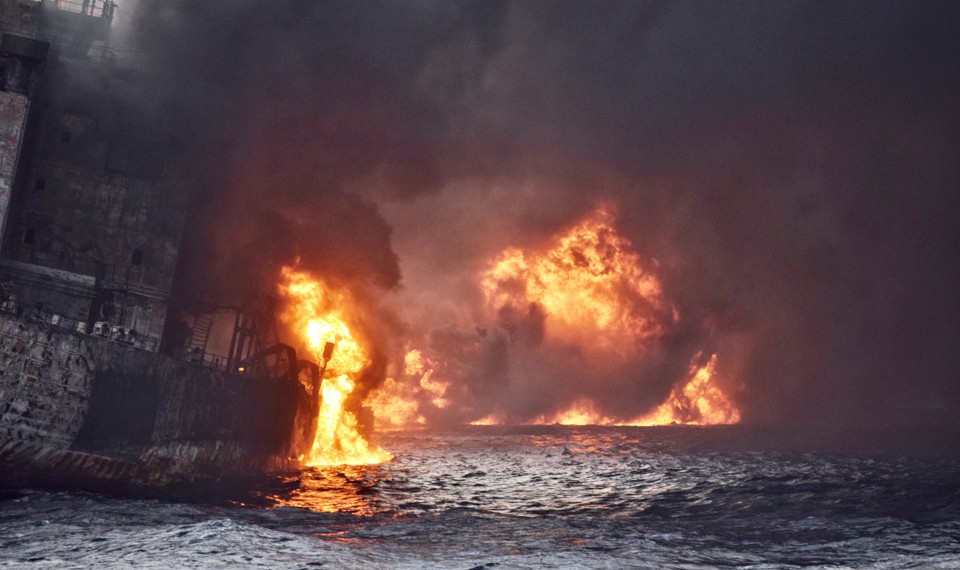88m3
Fast Money & Foreign Objects

The Sanchi engulfed in flame on January 13China Daily via Reuters
The Atlantic Daily, our free weekday email newsletter.
Over the last two weeks, the maritime world has watched with horror as a tragedy has unfolded in the East China Sea. A massive Iranian tanker, the Sanchi, collided with a Chinese freighter carrying grain. Damaged and adrift, the tanker caught on fire, burned for more than a week, and sank. All 32 crew members are presumed dead.
Meanwhile, Chinese authorities and environmental groups have been trying to understand the environmental threat posed by the million barrels of hydrocarbons that the tanker was carrying. Because the Sanchi was not carrying crude oil, but rather condensate, a liquid by-product of natural gas and some kinds of oil production. According to Alex Hunt, a technical manager at the London-based International Tanker Owners Pollution Federation, which assists with oil spills across the world, there has never been a condensate spill like this.
“It’s typical for us to attend approximately 20 shipping incidents a year and we’ve been doing this for 50 years,” Hunt says. “There have been other condensate spills, but this is the first condensate spill of this magnitude that we’ve dealt with, which gives you an impression of how rare cases like this are.” A 2016 Canadian environmental risk report on condensates also noted “the small size and low frequency of spills to marine water.”
While it might seem that all oil spills would at least be similar, in this case that is not true. Underground, crude is a liquid you can pump. Condensate, on the other hand, is a gas amid the heat and pressure down there. Bring it up to the surface and it condenses into liquid. This liquid is made of hydrocarbons like crude—and is sometimes classed as a form of it—but contains a different mix of molecules than other crude oils.
That mix is substantially lighter, containing more small, simple molecules and fewer large, complex molecules. This composition—and the composition of any form of petroleum—is highly significant for the refiners who turn raw petroleum products into refined fuels and chemicals that they sell. But, in this case, the properties are salient to the disaster and the environmental aftermath.
In technical terms, condensate is primarily made up of alkanes, which you’ve probably encountered a few of in the past when you’re looking for something to burn: methane, propane, butane, and the octane of high-octane gasoline.
Condensate, as you might expect, is highly flammable, which explains the towering flames that are visible in some photographs and video of the incident. It’s also very low-density. It has a specific gravity that is much, much lower than water, which means that it almost certainly is going to rise to the surface after it is leaked, Hunt says.
“[There is] the classic image of a spill at sea—black oil floating on the water, people attempting to use booms and skimmers or to use dispersants,” he says. “In a case like this, a product like this, those techniques would not be recommended. It’s flammable so you wouldn’t want to contain it, or use a skimmer to recover it, because then you are risking a fire.” There have also been some reports that the condensate might dissolve in water and travel vast distances. Hunt does not think that is likely, saying the substance’s water solubility is very low.
While studies of condensate’s environmental effects are limited, one lab study found that its toxicity to corals, for example, was greater than expected based on its molecular components.
In the best-case scenario, the fuel will come to the surface in a slick that is massive but thousandths-of-millimeters thin. From there, it would evaporate into the atmosphere. However, as Richard Steiner, an Alaska-based environmental consultant, told BuzzFeed News, “there’s a lot we don’t know about a major condensate spill since we’ve never seen one.” He described a scenario where there was an “invisible, subsurface toxic plume that is spreading outward from the site.”
This Is an Unprecedented Kind of Oil Spill
not good





